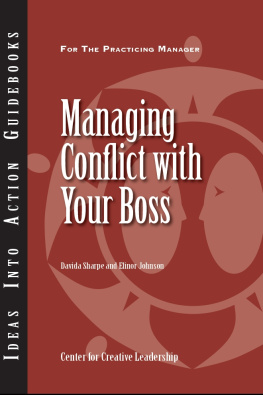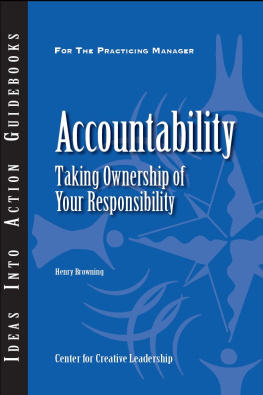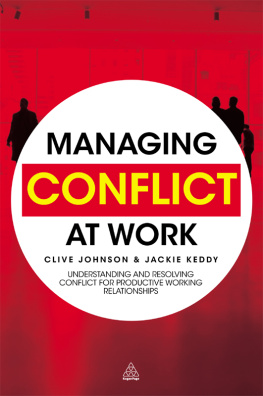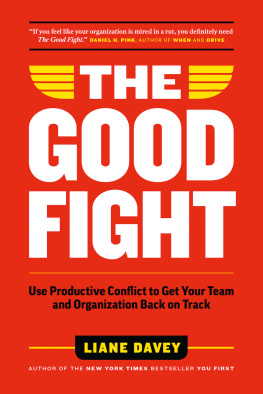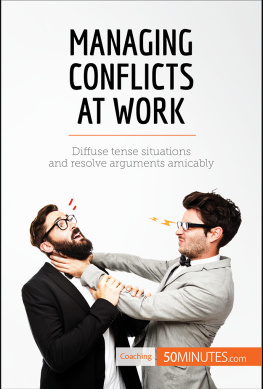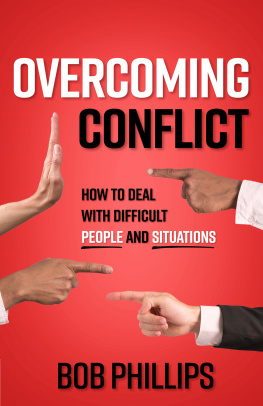IdeasIntoActionGuidebooks
Aimed at managers and executives who are concerned with their own and others development, each guidebook in this series gives specific advice on how to complete a developmental task or solve a leadership problem.
| LEAD CONTRIBUTORS | Davida Sharpe |
| Elinor Johnson |
| CONTRIBUTORS | Talula Cartwright |
| Daryl Anne Kline |
| Barbara Popejoy |
| Ellen Van Velsor |
| GUIDEBOOK ADVISORY GROUP | Victoria A. Guthrie |
| Cynthia D. McCauley |
| DIRECTOR OF PUBLICATIONS | Martin Wilcox |
| EDITOR | Peter Scisco |
| WRITER | Robert Bixby |
| DESIGN AND LAYOUT | Joanne Ferguson |
| CONTRIBUTING ARTISTS | Laura J. Gibson |
| Chris Wilson, 29 & Company |
Copyright 2002 Center for Creative Leadership.
All Rights Reserved. No part of this publication may be reproduced, stored in a retrieval system, or transmitted, in any form or by any means, electronic, mechanical, photocopying, recording, or otherwise, without the prior written permission of the publisher.
CCL No. 416
ISBN-13: 978-1-882197-70-5
ISBN-10: 1-882197-70-4
Center for Creative Leadership
Post offiCe Box 26300
GreensBoro, north CaroLina 27438-6300
336-288-7210
www.ccl.org/publications
pfeiffer.com/go/cclguidebooks

The Ideas Into Action Guidebook Series
This series of guidebooks draws on the practical knowledge that the Center for Creative Leadership (CCL) has generated in the course of more than thirty years of research and educational activity conducted in partnership with hundreds of thousands of managers and executives. Much of this knowledge is sharedin a way that is distinct from the typical university department, professional association, or consultancy. CCL is not simply a collection of individual experts, although the individual credentials of its staff are impressive; rather it is a community, with its members holding certain principles in common and working together to understand and generate practical responses to todays leadership and organizational challenges.
The purpose of the series is to provide managers with specific advice on how to complete a developmental task or solve a leadership challenge. In doing that, the series carries out CCLs mission to advance the understanding, practice, and development of leadership for the benefit of society worldwide. We think you will find the Ideas Into Action Guidebooks an important addition to your leadership toolkit.
Executive Brief
As individuals, we can be creative and ambitious in our personal lives and in our professional lives. But individual efforts cant always match the energy and productivity of a group. Cultures, societies, clubs, schools, and militaries arose out of our need to band together for mutual support. Organizations were created to deal more effectively with the environmentboth the natural world and the world of work. But there is a trade-off when we move from individual contributions to group efforts: the relationships necessary for working together can spawn conflict.
In organizations, tensions between individuals need to be defused, or focused in order to find productive solutions to problems. This is especially critical when conflict arises between people at different levels in the organization, such as when you are having a conflict with your boss. These tensions arent easy to handle. Conflict can generate discomfort, anger, and ineffective behavior. Feelings such as fear and resentment can rise to the surface. Organizational issues such as unclear lines of authority, power, politics, and ineffective support systems also come into play.
Although these internal and external factors create a rich and complicated landscape for conflict to flourish, a conflict with your boss doesnt necessarily spell the end of your career with an organization. There are steps you can take to gain perspective on conflict and to manage the conflict so that it focuses your energy and your bosss energy on the needs of the organization, moving both of you toward a more productive working relationship.
What Is Conflict?
The word conflict is often used to describe a wide range of disagreementseverything from minor squabbles to dysfunctional relationships to all-out war. At its core, conflict is disharmony, dissension, division, and discord between people, interests, or ideas. Conflict is also natural, and inherent to the human experience. Where there are people, there will be conflict.
Individuals perceive conflict differently, and those differences can make managing conflict extremely difficult. What to one person is a full-scale battle to another person is an opportunity to discuss divergent views. One person may define a poor relationship as conflict, but someone else may see the same relationship as difficult but not unusualjust whats expected when working with people who hold different perspectives. These disparate views about conflict can be even more disconcerting when the conflict is between you and your boss.
Why Managing Conflict Is Important
Since 1983 the Center for Creative Leadership has conducted research on derailmentcontrasting those people who make it to the top with people who were once successful but in the end were demoted, fired, or sidelined. In the research, successful managers were described as those who seek out, build, and maintain effective relationships with others. They listenwillingly, actively, and patiently. They willingly receive feedback and effectively respond to it. They support others ideas. They perform as promised and maintain commitments. Derailed managers were described as disconnected, disagreeable, dictatorial, and divisive. They mishandled interpersonal relationships. Specific examples of their ineffective relationships include having an unresolved interpersonal conflict with a boss and showing unprofessional behavior related to a disagreement with upper management.
The Look of Conflict
In a large manufacturing company, the vice president of operations hadten direct reports. She got along well with eight of the ten. Two of her reports, however, proved difficult to work with. From her perspective, she felt they were threatened by the changes she had instituted since taking her position because both employees were old timers. She also knew that they socialized together, and she thought this tended to encourage their mutual negativity. Despite the difficulties, she didnt regard her interactions with these two reports as a conflict situation. In her mind, conflicts resulted from personality clashes, not employee resistance. In this case she saw her direct reports as resisting change, and she saw herself as responsible for gaining their commitment.
The two direct reports, the director of quality and the director of manufacturing, described their relationship with the vice president as conflicted. From their perspective, every time they tried to disagree with their less experienced boss, she shut them down. They felt very frustrated. They thought they had tried to get through to her on numerous occasions, and had even talked about how unreceptive she was to their ideas. Because they saw the relationship as filled with conflict, they put more time and emotional energy into fixing the relationship than their boss did. This inequity caused even greater frustration and eventually stopped communication up the chain from director to vice president.

